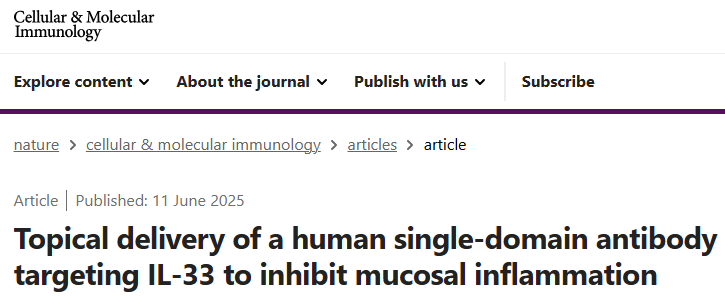Topical Delivery of Human Single-Domain Antibodies Targeting IL-33 Shows Potential to Treat Mucosal Inflammation

Treating mucosal inflammation in areas like the eyes or lungs is a major therapeutic challenge due to the poor permeability of biological drugs through epithelial barriers. A new study offers a compelling solution through the use of human single-domain antibodies, or UdAbs.
What Are UdAbs and Why IL-33?
UdAbs are human-engineered single-domain antibodies similar in structure and function to camelid-derived nanobodies (VHHs). In this study, researchers developed an anti-IL-33 UdAb, named A12, targeting the pro-inflammatory cytokine interleukin-33 (IL-33), a key player in mucosal immune responses.
How A12 Works
Unlike traditional antibodies that block IL-33 receptor binding directly, A12 inhibits IL-33 signaling through a different mechanism. Despite this, it showed strong anti-inflammatory activity in both ocular and pulmonary inflammation models.
Key Findings:
Topical delivery of A12 led to significantly higher corneal concentrations than a full-size anti-IL-33 IgG (itepekimab), with minimal systemic penetration.
In a dry eye disease model, A12 reduced inflammation and disease severity after eye drop treatment.
In a mouse model of allergic asthma, inhaled A12 lowered lung inflammation and immune cell infiltration.
Why This Matters
The ability of UdAbs to cross mucosal barriers and remain effective at local sites could revolutionize treatments for chronic inflammatory conditions such as dry eye disease and allergic asthma. Their small size, stability, and ease of formulation make them ideal candidates for topical or inhaled therapies.
A Step Forward for Nanobody Therapeutics
This research highlights the unique advantages of single-domain antibodies beyond intravenous applications. The success of A12 reinforces the therapeutic potential of UdAbs as minimally invasive, targeted therapies for mucosal inflammation.
As research continues to validate and expand these findings, UdAbs may soon form the foundation of next-generation biologics for localized immune modulation.
Source: Nature